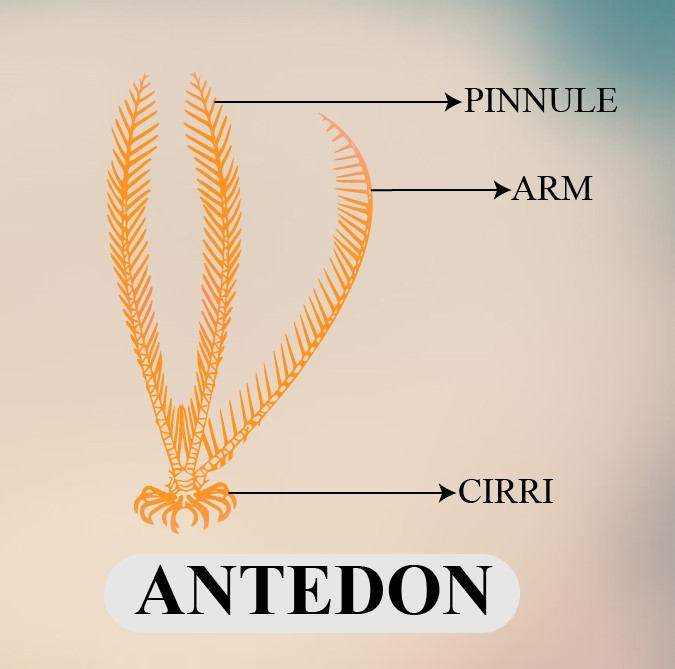
Antedon is a member of the class
A. Echinoidea
B. Asteroidea
C. Crinoidea
D. Ophiuroidea
Answer
583.5k+ views
Hint: Antedon is a member of the class which has feathery arms and thus are commonly known as sea lilies or feather stars. They are free-living but can also attach to the substratum by specialised appendages on their central disc.
Complete answer:
Antedon is a member of the class Crinoidea. ‘Echinos’ means spiny while ‘dermos’ means skin and thus they are famously known as the spiny skinned animals. All the animals in this Phylum are exclusively marine. Phylum Echinodermata is divided into five classes- Asteroidea, Ophiuroidea, Echinoidea, Holothuroidea and Crinoidea.Additional Information:
Echinoderms generally live at the sea bottom. Some are free swimmers or pelagic while some are sessile i.e attached to the substratum Their body is usually star-shaped, though some are spherical and cylindrical too. This phylum is known for its characteristic ambulacral system or in common terms water vascular system.
Some characteristic features of Antedon are :
-Its body has a central disc-like structure allied to a calyx. It bears five arms and each arm is further bifurcated, bearing a row of lateral extensions known as pinnules. The presence of pinnules gives Antedon a feathery appearance. This is the reason it is commonly known as a feather star too.
-The central disc is differentiated into an oral and aboral surface. The oral surface contains mouth and anus while aboral surface bears arms and cirri. Cirri are unbranched appendages on the central disc and help in its temporary attachment to the substratum.
-Antedon has a great power of autotomy and regeneration.

So, the correct answer is ‘Crinoidea’.
Note: Autotomy is a self-defence method observed in many animals in which they cut off a part of their body( arm in case of Antedon) when attacked by a predator. This gives an illusion that the animal is dead and distracts the predator. The animal takes advantage of this and runs away to protect itself. The deliberate cutting of a part of its body is not harmful to the animal for it has the power to regenerate its lost part.
Complete answer:
Antedon is a member of the class Crinoidea. ‘Echinos’ means spiny while ‘dermos’ means skin and thus they are famously known as the spiny skinned animals. All the animals in this Phylum are exclusively marine. Phylum Echinodermata is divided into five classes- Asteroidea, Ophiuroidea, Echinoidea, Holothuroidea and Crinoidea.Additional Information:
Echinoderms generally live at the sea bottom. Some are free swimmers or pelagic while some are sessile i.e attached to the substratum Their body is usually star-shaped, though some are spherical and cylindrical too. This phylum is known for its characteristic ambulacral system or in common terms water vascular system.
Some characteristic features of Antedon are :
-Its body has a central disc-like structure allied to a calyx. It bears five arms and each arm is further bifurcated, bearing a row of lateral extensions known as pinnules. The presence of pinnules gives Antedon a feathery appearance. This is the reason it is commonly known as a feather star too.
-The central disc is differentiated into an oral and aboral surface. The oral surface contains mouth and anus while aboral surface bears arms and cirri. Cirri are unbranched appendages on the central disc and help in its temporary attachment to the substratum.
-Antedon has a great power of autotomy and regeneration.

So, the correct answer is ‘Crinoidea’.
Note: Autotomy is a self-defence method observed in many animals in which they cut off a part of their body( arm in case of Antedon) when attacked by a predator. This gives an illusion that the animal is dead and distracts the predator. The animal takes advantage of this and runs away to protect itself. The deliberate cutting of a part of its body is not harmful to the animal for it has the power to regenerate its lost part.
Recently Updated Pages
Master Class 11 Business Studies: Engaging Questions & Answers for Success

Master Class 11 English: Engaging Questions & Answers for Success

Master Class 11 Computer Science: Engaging Questions & Answers for Success

Master Class 11 Social Science: Engaging Questions & Answers for Success

Master Class 11 Maths: Engaging Questions & Answers for Success

Master Class 11 Biology: Engaging Questions & Answers for Success

Trending doubts
One Metric ton is equal to kg A 10000 B 1000 C 100 class 11 physics CBSE

Explain zero factorial class 11 maths CBSE

An example of chemosynthetic bacteria is A E coli B class 11 biology CBSE

State the laws of reflection of light

What is 1s 2s 2p 3s 3p class 11 chemistry CBSE

Which one of the following is not a method of soil class 11 biology CBSE




